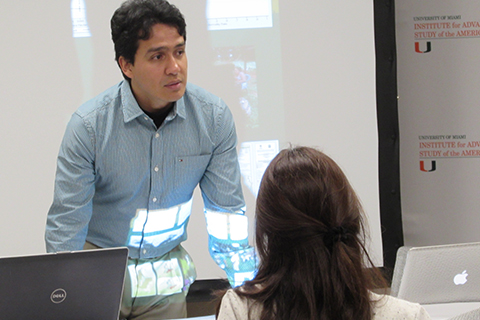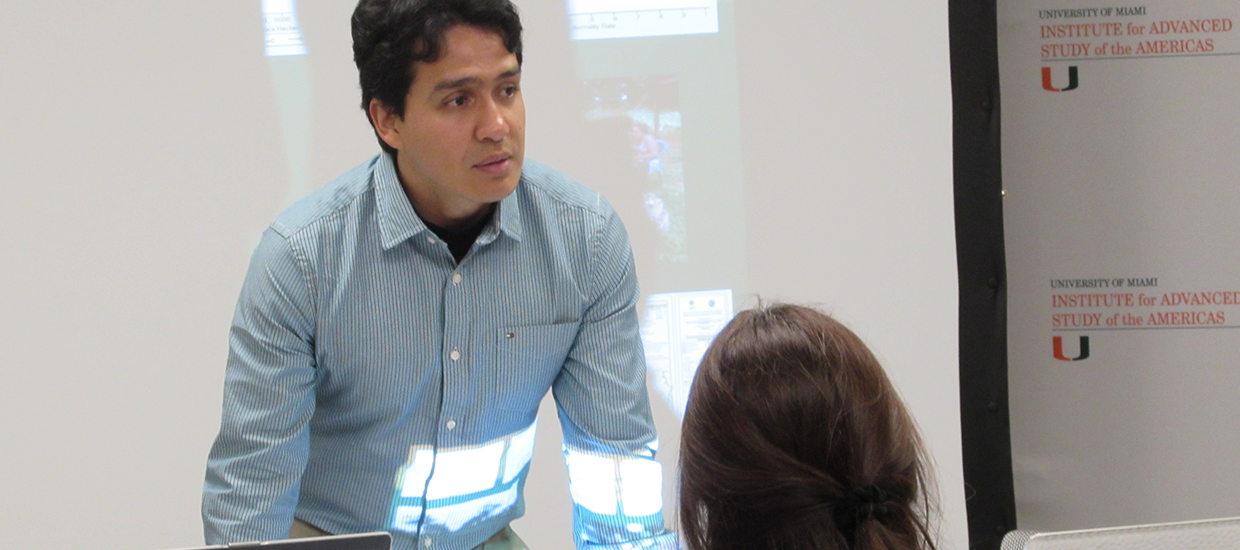- Accessibility Options:
- Skip to Content
- Skip to Search
- Skip to footer
- Office of Disability Services
- Request Assistance
- 305-284-2374
- Display:
- Default
- High Contrast
- Apply
- About UM
- Give to UM
-
Schools
- School of Architecture
- College of Arts and Sciences
- Miami Herbert Business School
- School of Communication
- School of Education and Human Development
- College of Engineering
- School of Law
- Rosenstiel School of Marine, Atmospheric, and Earth Science
- Miller School of Medicine
- Frost School of Music
- School of Nursing and Health Studies
- The Graduate School
- Division of Continuing and International Education
- Alumni
- After Hurricane Matthew
- Land Concentration and Land Grabbing in the Colombian Frontier
- Innovations in Community Lawyering with Transnational Labor Migrants
- Cuba's Digital Millennials
- The Perfect Storm: Understanding the Crisis in Puerto Rico
- Colombia's Peace Process
- Borders and Migrations in the Trump Era
- Progress of Women in Latin America and the Caribbean
- Hemispheric Caribbean Studies: Collaborative Research and Teaching Proposals
- Colloquium Spanish Legacies: The Coming of Age of the Second Generation
- Memoir of My Youth in Cuba
- Town Hall After Hurricane Matthew: Resources, Capacities, and Pathways to Recovery of Devastated Communities in Haiti
- Symposium Gender Equality Post-Millennium in Latin America: Achievements and Challenges
- USA Influence in the Legal Construction of the Foreigner as a Threat in 20th Century South America
- Becoming Black Political Subjects: Movements and Ethno-Racial Rights in Colombia and Brazil
- Women in Leadership Series
- Open Discussion on Caribbean Studies at the University of Miami
- Justice Barometer
- The Future of the EU-US Relations and its Effects on the Western Hemisphere
- Cuban Architects at Home and in Exile: The Modernist Generation
- The Role of Social Skills and Networks in the Fight against Poverty
- Science, Politics and Research Integrity in Latin America and the Caribbean: The View from Mexico
- The Media and Populism in Latin America: Lessons for the U.S. and beyond
- Gender Illegality in the Lives of Undocumented Young Adults
- Mexico's Nobodies: The Cultural Legacy of the Soldadera and Afro-Mexican Women
- Rusty Pipes and Broken Toilets: The Water Crisis in Cuba
- A Sugarcane Immigration Status: The History of Statelessness in the Dominican Republic
- Hurricane Risks, Direct Foreign Investment and Sustainable Tourism in the Caribbean
- History of Drug Trafficking in Colombia
- 2017 Distinguished Fellows Series
- Other Events
- After Hurricane Matthew
- Land Concentration and Land Grabbing in the Colombian Frontier
- Innovations in Community Lawyering with Transnational Labor Migrants
- Cuba's Digital Millennials
- The Perfect Storm: Understanding the Crisis in Puerto Rico
- Colombia's Peace Process
- Hemispheric Caribbean Studies: Collaborative Research and Teaching Proposals
- Progress of Women in Latin America and the Caribbean
- Borders and Migrations in the Trump Era
- Colloquium Spanish Legacies: The Coming of Age of the Second Generation
- Memoir of My Youth in Cuba
- Symposium Gender Equality Post-Millennium in Latin America: Achievements and Challenges
- Town Hall After Hurricane Matthew: Resources, Capacities, and Pathways to Recovery of Devastated Communities in Haiti
- USA Influence in the Legal Construction of the Foreigner as a Threat in 20th Century South America
- Becoming Black Political Subjects: Movements and Ethno-Racial Rights in Colombia and Brazil
- Open Discussion on Caribbean Studies at the University of Miami
- Women in Leadership Series
- Justice Barometer
- The Future of the EU-US Relations and its Effects on the Western Hemisphere
- Cuban Architects at Home and in Exile: The Modernist Generation
- The Role of Social Skills and Networks in the Fight against Poverty
- Science, Politics and Research Integrity in Latin America and the Caribbean: The View from Mexico
- The Media and Populism in Latin America: Lessons for the U.S. and beyond
- Gender Illegality in the Lives of Undocumented Young Adults
- Mexico's Nobodies: The Cultural Legacy of the Soldadera and Afro-Mexican Women
- Rusty Pipes and Broken Toilets: The Water Crisis in Cuba
- A Sugarcane Immigration Status: The History of Statelessness in the Dominican Republic
- Hurricane Risks, Direct Foreign Investment and Sustainable Tourism in the Caribbean
- History of Drug Trafficking in Colombia
- 2017 Distinguished Fellows Series
- Other Events





